The Legend of Zelda Majora’s Mask
Retro Game Review
Summary
The Legend of Zelda: Majora’s Mask takes place almost directly following its predecessor, Ocarina of Time, in what is known as the child timeline of the series. The main protagonist, Link, after completing his journey in Hyrule and saving the day, embarks on a journey to search for his fairy companion, Navi, who leaves during the epilogue of Ocarina of Time. After being mugged by a mysterious skull kid wearing a peculiar mask, Link finds himself in the world of Termina with a deadline of three days to retrieve the skull kid’s mask before the even more mysterious Happy Mask Salesman departs from Termina. Coincidentally, the three-day deadline also marks the countdown to when the looming moon will crash into the earth.
With the help of a new fairy companion, Tatl, Link must awaken four giants and retrieve the skull kid’s mask in order to rescue the world of Termina from its doom.
Protagonist
Link
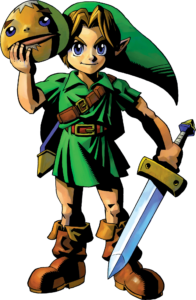
As with all the Legend of Zelda games, Link is your main protagonist who is on a search for his beloved friend, Navi, and gets sucked into saving the world. Again.

Link is roughly 11 years old in this game and takes on several forms throughout the course of the game: human, Deku, Goron, Zora, and Diety.
Gameplay
Time
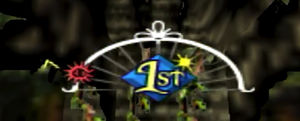

Majora’s Mask takes Link through an endless cycle of same three days during his journey. At the bottom of the player’s screen, there is a time clock (or a bar, in the remake) at the bottom of the player’s main screen that counts down how much time Link has left until the Happy Mask Salesman’s departure and the destruction of Termina.
Using the power of the Ocarina of Time, Link can play the Song of Time to take him back to his first arrival in Termina. Major items that Link can obtain (such as masks, his ocarina, and various weapons) will travel with Link when he travels back in time; however, ammo and rupees are lost. Additionally, tasks that Link performs during a single three-day span must be completed before the end of the third day or all progress of that task will be lost. For more information on this, see the Bomber’s Notebook section.
Link can also play songs to slow down or speed up the flow of time.
It is not expected for Link to be able to do everything in a single cycle. In fact, many side-quests will require Link to go back in time and perform various tasks (some of which overlap with other tasks, which is why Link must travel back through multiple cycles to complete them).
Masks
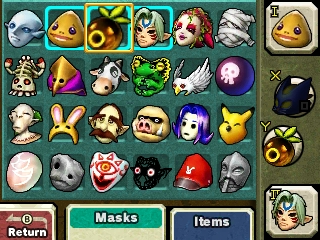
There is a heavy emphasis on masks throughout this game, both in their physical nature and the symbolism they represent. There is a total of 24 masks that Link can obtain during his journey, five of which are transformation masks. Most of the masks that Link can obtain are completely optional but collecting 23/24 masks will allow Link to obtain a special mask.
Some masks allow Link to perform special abilities, like the Great Fairy Mask allowing Link to attract lost stray fairies, and the Bunny Hood allowing Link to move faster. Others are used to progress side-quests, like Kafei’s Mask allowing Link to start up the Anju/Kafei side-quest.
Transformations
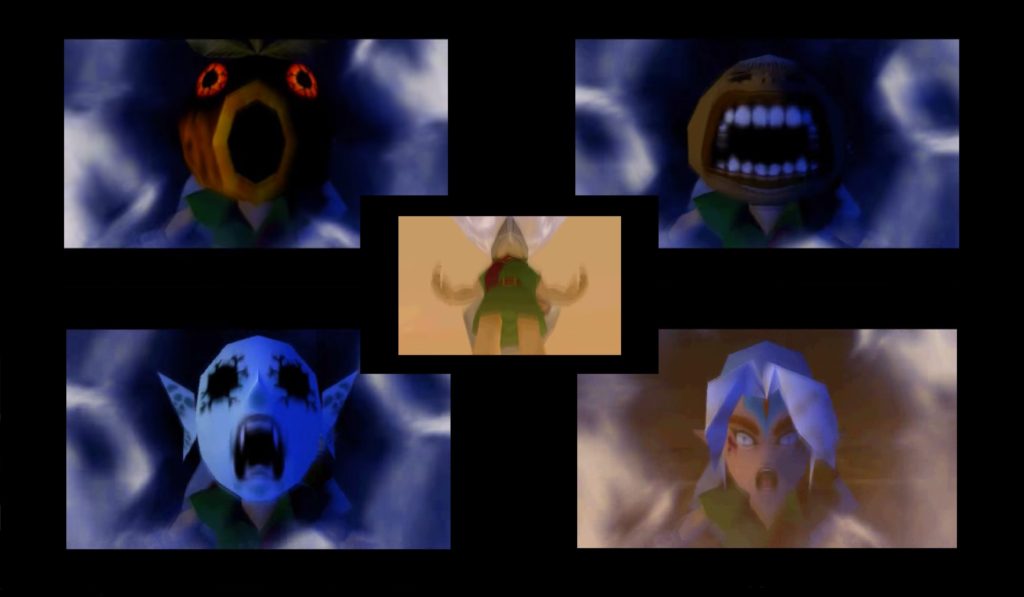
Link is able to use five transformation masks during his journey: Deku Mask, Goron Mask, Zora Mask, Fierce Diety Mask, and Giant’s Mask.
The Deku Mask enables Link to transform into a small Deku Scrub who can shoot bubbles from his mouth. He performs a rapid spin which acts as both a form of movement as well as a way to attack. His special ability is burrowing into Deku flowers and popping out to fly a short distance using two small flowers.
The Goron Mask enables Link to transform into a Goron that resembles the great Darmani, a hero of the Goron people. Goron Link can curl into a ball and roll rapidly before spikes will emerge from his body, damaging all in his path. The spikes use up magic power, though, so it can only be used for a short period unless Link has had a bottle of Cheatau Romani. Goron Link’s weight allows him to body slam large buttons to activate them.
The Zora Mask enables Link to transform into a Zora that resembles Mikau, a guitarist for the famous band, the Indigo-Go’s. Zora Link is best used for swimming underwater and being able to fight underwater. He can also channel magic power to create a powerful electric shield around him. If Zora Link swims fast enough, he can break through certain underwater barriers.
The Fierce Diety Mask enables Link to transform into a powerful diety that resembles his adult form from Ocarina of Time with some coloration to his clothes, hair, and eyes. This mask can only be obtained if the player meets certain criteria in the game. Fierce Diety Link can only be used during boss fights and consumes a large amount of magic power to shoot magic beams from his sword.
The Giant’s Mask makes Link turn into a giant version of himself. Giant Link can only be used during the final boss battle of the Stone Tower Temple. Giant Link behaves the same as regular Link, though his movements are a bit slower due to his size.
Bomber’s Notebook
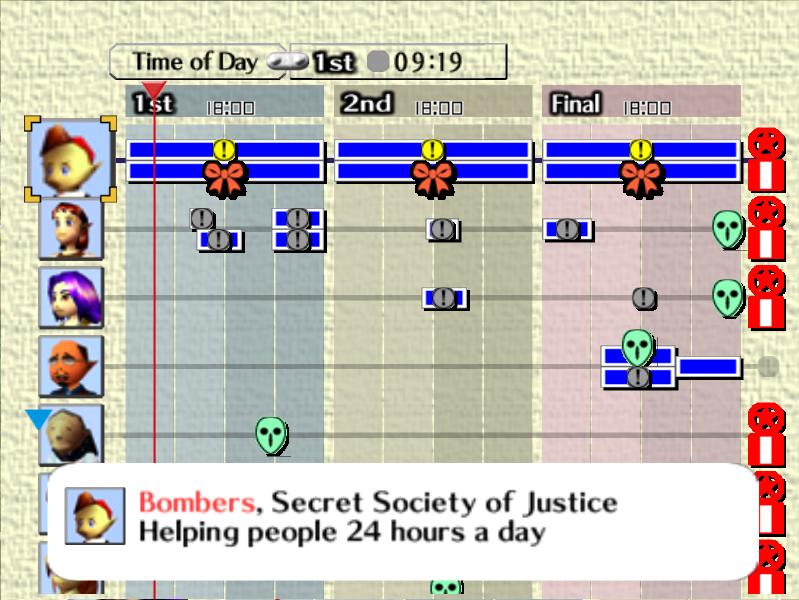

In the original iteration of the game, the Bomber’s Notebook was obtained from one of the members of the Bomber’s Secret Society of Justice and was an optional guide to help you keep track of your side-quest progression. In the remake, however, the key item became much more involved with side-quest tracking as well as tracking “rumors” to help the player determine their next course of action or what the next side-quest they should take on.
While nearly all of the side-quests in Majora’s Mask are optional, many of them reward you with masks, pieces of heart, or items.
Dungeons
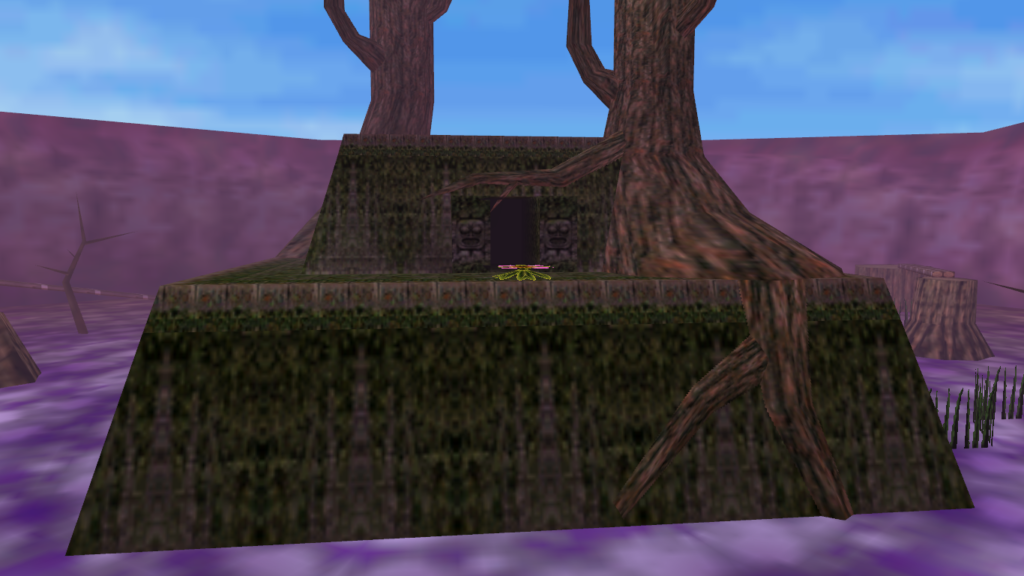
There are five major dungeons that Link must trek through: four to awaken the slumbering giants and one to reach the final boss. The first four major dungeons are located within the four cardinal directions of the Termina map where four major zones lie: Woodfall Temple in the Southern Swamp, Snowhead Temple in the Northern Mountain Village, Great Bay Temple in the Western Great Bay, and the Stone Tower Temple in the Eastern Ikana Valley. Upon completing these four dungeons, Link is granted with the remains of the bosses which represents him freeing the souls of the great giants that defend Termina.
While a dungeon can both be unlocked and completed in a single cycle, it is recommended that once the requirements are met to unlock the temple, you should go back in time and use the new cycle to complete the dungeon.
Saving
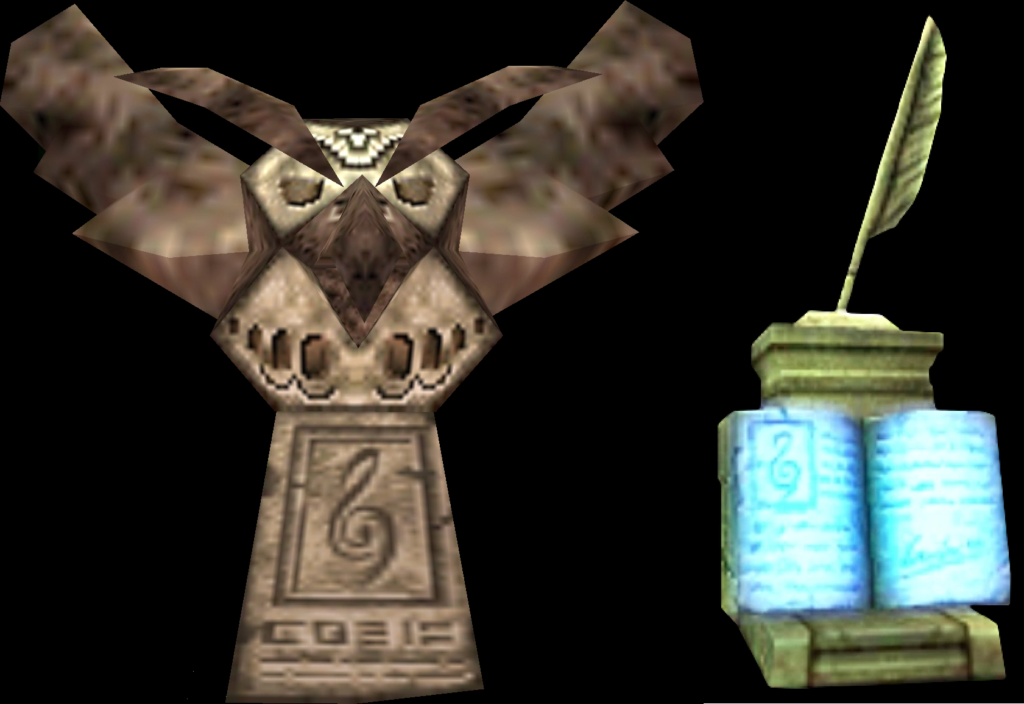
In the original iteration of the game, there were only two methods of saving: Playing the Song of Time and going back in time OR saving at an Owl Statue. Owl Statue saves were temporary saves that were lost upon starting the game back up whereas the Song of Time was a permanent save option.
In the remake of the game, the Song of Time no longer saves your progress. Owl Statues are more prominent and a new type of statue, the Quill Statue, make an appearance to allow the player more places to save.
Songs
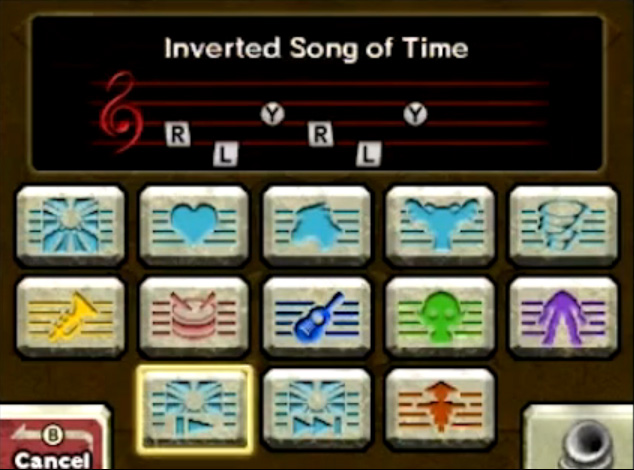
Songs play a key part in both Ocarina of Time and Majora’s Mask. In Majora’s Mask, each song has some sort of importance —
Song of Time: The Song of Time is played to allow you to go back to Dawn of the First Day. In the original release of the game, this song was also used to save the game. There is also the Inverted Song of Time, which slows down time, and the Song of Double Time, which allows you to move forward in time.
Song of Healing: The Song of Healing is used to ease the suffering of pained souls. Most often, your reward for easing a pained soul is the mask that represents that soul (such as the Goron Mask, Zora Mask, and Kamaro’s Mask, to name a few).
Song of Storms: The Song of Storms can blow away curses and make plants grow. It is also used during a scene in Ikana Valley.
Epona’s Song: Epona’s Song summons your faithful steed, Epona, while out in Termina Field or any area where Epona can be ridden. This song can only be learned if you meet certain prerequisites.
Song of Soaring: The Song of Soaring is used to allow you to fast travel to activated Owl Statues. It cannot be used to travel to Quill Statues.
Sonata of Awakening: Gives you access to the Woodfall Temple.
Goron’s Lullaby: Gives you access to the Snowhead Temple.
New Wave Bossa Nova: Gives you access to the Great Bay Temple.
Elegy of Emptiness: Gives you the ability to create empty (and creepy) statues of each of Links forms and also allows access to the Stone Tower Temple.
Oath to Order: When all the requirements have been met, this song can be used at the end of the game to summon the four giants to help save the world. Yay!
Original 2000 Release – Nintendo 64 vs Remake 2015 Release – Nintendo 3Ds
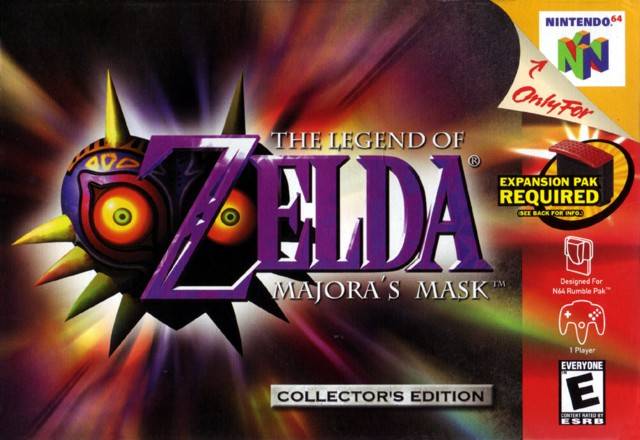
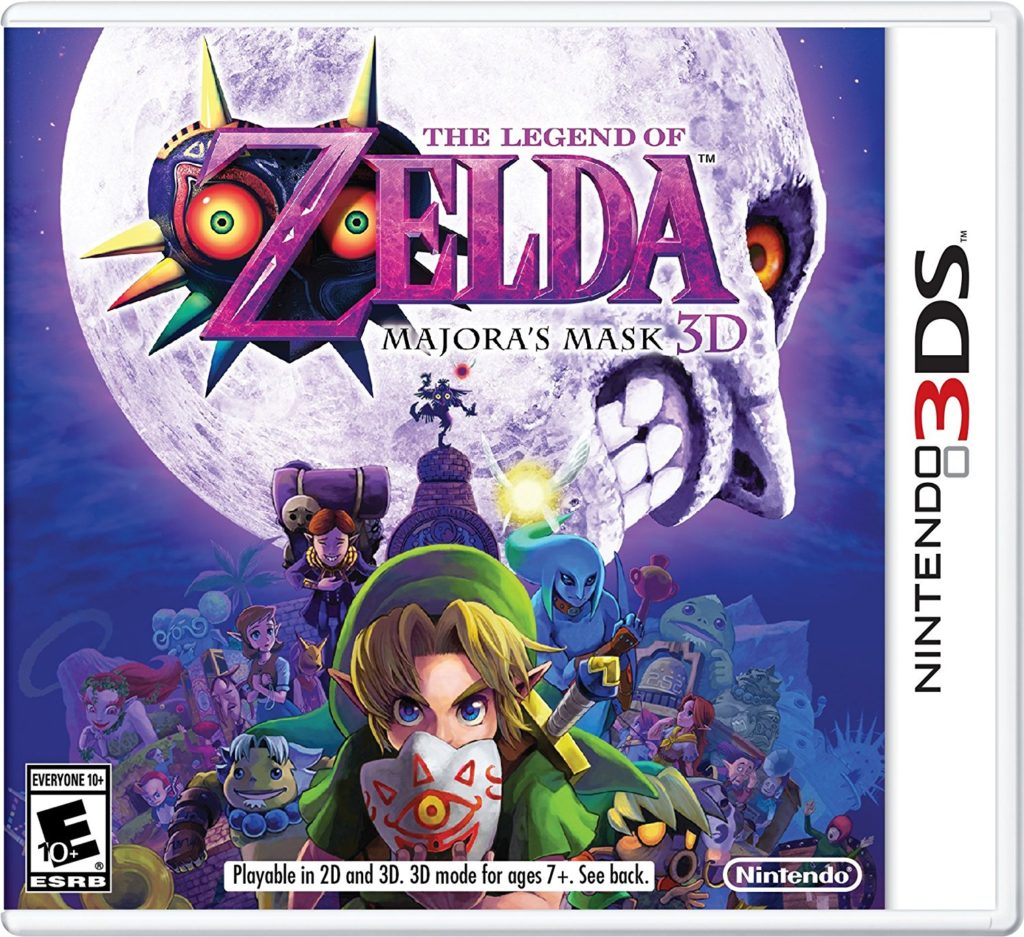
This game has seen two versions: The original iteration, released on the Nintendo 64 in 2000, and the remake, released on the Nintendo 3DS in 2015. The game was also on the Collector’s Edition for Gamecube released in 2003.
The N64 version of the game required an expansion pack to be added to the Nintendo 64 in order for the game to be played. There were no major prerequisites to being able to play the 3DS version.
While the two games are similar in terms of plot and primary mechanics, they added a lot of aspects to the 3DS version that made the game easier for newer players. It included the Sheikah Stone (which was introduced in the Ocarina of Time 3DS) which gave the player hints of where they need to go next. The Bomber’s Notebook further solidified this with the rumor system as well as adding an alarm system to alert the player when a particular event was about to occur. Locations of certain items also changed between the two iterations, such as Stray Fairies and certain masks.
Opinion Corner
Honestly, Majora’s Mask is my favorite game in the entire Legend of Zelda series so far. Twilight Princess got pretty close, mostly because I’m a big fan of the darker Zelda games, but it doesn’t even come close to Majora’s Mask.
What I enjoyed most about Majora’s Mask was the depth of each character. While the character models were very obviously recycled from Ocarina of Time characters, it gave the developers more of an opportunity to delve into the character personalities and how they faced their impending dooms. My favorite set of people to watch over the 3-day span was Cremia and Romani. Cremia knew of the inevitable fate they were about to face while Romani was blissfully innocent. The Anju and Kafei side-quest (which also happens to be one of the longest side-quests in the game) also really spoke loud in terms of how each character reacted to each action Link took. Likewise, each character also had a unique interaction even when Link didn’t directly interfere with their lives during a particular cycle.
The time cycle was also one of the most unique mechanics in a Zelda game, by far. While many players often complain about it, I rather enjoyed having a concept of time and knowing that each day would be different from the day before. Even if they repeated during the cycles, it was still nice to break up a character’s default dialogue once in a while. I could talk to pretty much anyone and get a new response depending on what day I talked to them and what actions I took (or didn’t take) in their lives.
It’s a game that I would recommend again and again, and a game that I would happily play again and again.

